 W
WAmblyopone australis, the southern Michelin ant, is a species of ant in the genus Amblyopone, native to Australia. The species was described by Wilhelm Ferdinand Erichson in 1842. Workers can vary in colour from yellow to dark brown or black. They have a body length of 4.5–8mm; queens are larger.
 W
WThe Argentine ant, formerly Iridomyrmex humilis, is an ant native to northern Argentina, Uruguay, Paraguay, Bolivia and southern Brazil. It is an invasive species that has been established in many Mediterranean climate areas, inadvertently introduced by humans to many places, including South Africa, New Zealand, Japan, Easter Island, Australia, Europe, Hawaii, and the continental United States.
 W
WAustroponera is a ponerine genus of ants found in Australia and New Zealand, hence the prefix "Austro-".
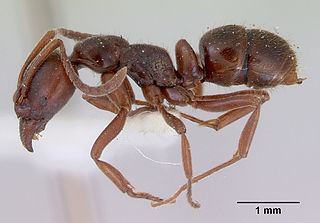 W
WAustroponera castanea is an ant species in the subfamily Ponerinae. It is endemic to New Zealand.
 W
WAustroponera castaneicolor is an ant species of the subfamily Ponerinae, endemic to the North Island, and the north and north west of the South Island, of New Zealand.
 W
WCardiocondyla minutior is a species of ant in the subfamily Myrmicinae. It is a widespread ant species, and not invasive in nature.
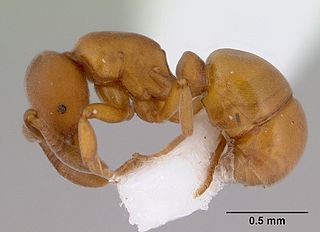 W
WDiscothyrea antarctica is a species of ant in the genus Discothyrea and is endemic to New Zealand. It is found in native forests throughout the country.
 W
WDoleromyrma darwiniana is a species of ant in the genus Doleromyrma. Described by Forel in 1907, the species is endemic to Australia and introduced to New Zealand, and it nests in soil or under stones and logs. The organism grows to a length between 2.0 and 3.0 millimeters. This species of ant maintains small colony sizes and it "prefers protein food." The species is also known by some sources as the "brown house ant" and "Darwin's ant". The species is considered a "minor urban pest" in New South Wales.
 W
WFulakora saundersi is a species of ant in the genus Fulakora, endemic to New Zealand.
 W
WThe green-head ant, also known as the green ant or metallic pony ant, is a species of ant that is endemic to Australia. It was described by British entomologist Frederick Smith in 1858 as a member of the genus Rhytidoponera in the subfamily Ectatomminae. These ants measure between 5 to 7 mm. The queens and workers look similar, differing only in size, with the males being the smallest. They are well known for their distinctive metallic appearance, which varies from green to purple or even reddish-violet. Among the most widespread of all insects in Australia, green-head ants are found in almost every Australian state, but are absent in Tasmania. They have also been introduced in New Zealand, where several populations have been established.
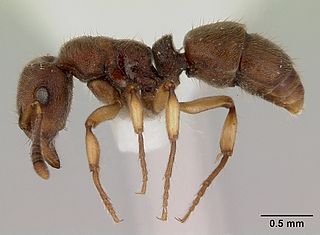 W
WHeteroponera brouni is a species of ant in the genus Heteroponera. It is endemic to the North Island of New Zealand, and the Three Kings Islands.
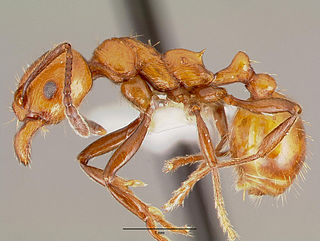 W
WHuberia is a genus of ants in the subfamily Myrmicinae. The genus contains two species endemic to New Zealand.
 W
WHuberia brounii is a species of ant in the genus Huberia, endemic to New Zealand.
 W
WHuberia striata is a species of ant in the genus Huberia, endemic to New Zealand.
 W
WHypoponera punctatissima, or Roger's ant, is a species of ant in the family Formicidae.
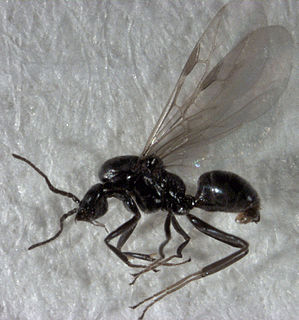 W
WIridomyrmex suchieri is a species of ant in the genus Iridomyrmex. Described by Forel in 1907, the species is endemic to Australia, but has also been recorded from New Zealand.
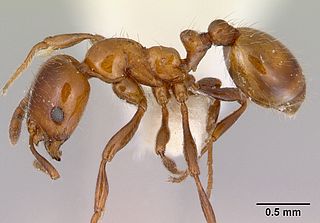 W
WMonomorium antarcticum is an ant of the family Formicidae, endemic to New Zealand. Also known as the southern ant, this is likely New Zealand's most common native ant species. Because it is highly variable in size (3–5mm), colour, and colony structure, it is possible that it consists of a complex of closely related species. It has a generalist diet, including small arthropods, nectar, and seeds, and it also tends aphids, scale insects, and mealybugs to obtain honeydew.
 W
WMonomorium fieldi is an ant of the family Formicidae, endemic to the North Island and the north of the South Island of New Zealand. It is found in a wide variety of habitats, but is very uncommon in forests.
 W
WMonomorium smithi is an ant of the family Formicidae, endemic to New Zealand.
 W
WOchetellus glaber is a species of ant native to Australia. A member of the genus Ochetellus in the subfamily Dolichoderinae, it was described by Austrian entomologist Gustav Mayr in 1862. Aside from Australia, O. glaber has been introduced to a number of countries, including China, India, Japan, New Zealand, the Philippines and the United States, where it has established itself in Hawaii and Florida. It has been found on Lord Howe Island, New Caledonia, Norfolk Island, Réunion and the Solomon Islands. Compared with other ants, O. glaber is a small species, with workers measuring 2–3 mm (0.079–0.118 in). Males are the smallest at 1.6 mm (0.063 in), while the queens measure 5.2–5.5 mm (0.20–0.22 in). The ant's colour ranges from brown to black.
 W
WThe pharaoh ant is a small (2 mm) yellow or light brown, almost transparent ant notorious for being a major indoor nuisance pest, especially in hospitals. The pharaoh ant, whose origins are unknown, has now been introduced to virtually every area of the world, including Europe, the Americas, Australasia and Southeast Asia. It is a major pest in the United States, Australia, and Europe.
 W
WPheidole megacephala is a species of ant in the family Formicidae. It is commonly known as the big-headed ant in the USA and the coastal brown ant in Australia. It is a very successful invasive species and is considered a danger to native ants in Australia and other places. It has been nominated as one of the hundred "World's worst" invaders.
 W
WPlagiolepis alluaudi, the little yellow ant, is a species of Plagiolepis. The species is native to Madagascar, an island off the coast of East Africa. It is known to be a widespread invasive species. In an effort to distinguish its name from other small and yellow species of ant it may be called Alluaud's little yellow ant, after Charles A. Alluaud.
 W
WProlasius advenus is a species of ant in the genus Prolasius. It is endemic to New Zealand, widespread across the North and South Islands, including offshore islands. It is a relatively small ant, with workers 2.9-3.5mm in length. Its common name is small brown bush ant.
 W
WStrumigenys xenos is a species of ant in the subfamily Myrmicinae. It is found in Australia and New Zealand.
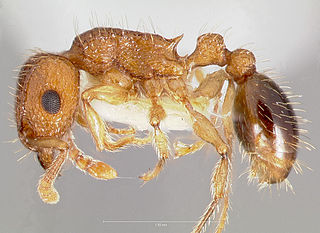 W
WTetramorium bicarinatum, is a species of ant of the family Formicidae in the order Hymenoptera that originated in South East Asia.